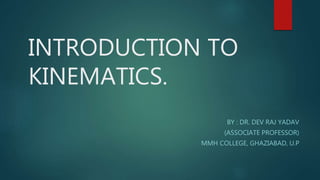
Introduction to Kinematics
- 1. INTRODUCTION TO KINEMATICS. BY : DR. DEV RAJ YADAV (ASSOCIATE PROFESSOR) MMH COLLEGE, GHAZIABAD, U.P
- 2. MOTION: Motion is a change in position of an object over time. Motion is described in terms of displacement, distance, velocity, acceleration, time and speed. Motion of a body is observed by attaching a frame of reference to an observer and measuring the change in position of the body relative to that frame. If the position of a body is not changing with respect to a given frame of reference, the body is said to be at rest. An object's motion cannot change unless it is acted upon by a force, as described. Momentum is a quantity which is used for measuring motion of an object. An object's momentum is directly related to the object's mass and velocity.
- 3. TYPES OF MOTION: Translatory motion is the motion of a particle in a straight line. A bus travelling on a straight road and an apple falling from a tree are examples of this kind of motion. Rotational motion refers to the motion of a body around a fixed axis. A spinning top, a bead moving on a circular track and Earth’s rotation are examples of this kind of motion. The word ‘linear’ means ‘straight’ and the word ‘motion’ means ‘change in position with respect to a frame of reference’. So, a body moving in a straight line with respect to a frame of reference is said to be in linear motion. An example of this is the motion of an ant on a straight wire. Angular motion is the angle made during the motion of the body about the fixed axis. It is equal to the angle passed over at the point or axis by a line drawn from the given fixed axis of rotation.
- 4. Speed Speed is defined as the rate of distance covered by a body. Mathematically, speed is given as: speed = It is a scalar quantity; that means no direction is required. (Implies that speed cannot be negative) Average Speed A body travelling from one location to another might stop, slow down, speed up or move at a constant speed. The average speed of a body is defined as the total distance travelled divided by the total time taken. Mathematically, average speed is given as:-
- 5. VELOCITY: When we include the direction of motion with speed, we are talking of the physical quantity called velocity. Thus, velocity is speed with direction. Velocity is defined as the rate of change of displacement. Velocity= It is a vector quantity. Therefore, direction of movement is important. (Implies that velocity contains algebraic sign) Average Velocity- A body moving from one point to another may change its velocity a number of times, but it will have an average velocity of its journey. Average velocity of a body is defined as the net displacement divided by the total time of travel. It is a vector quantity. Its SI unit is m/s and it can be positive, negative or zero AveragevelocitY=
- 6. ACCELERATION: Acceleration is defined as the rate of change of velocity. It is a vector quantity and its direction is given by the direction of the force causing the acceleration. Mathematically, acceleration is given as: Accelerations= Change in velocity Suppose the velocity of a car is u at time t1. Later, at time t2, its velocity becomes v. Change in velocity = (v − u), time interval = t2 − t1
- 7. Uniform and Non Uniform Acceleration Uniform Acceleration- If the rate of change of velocity remains constant, then the acceleration is uniform. Examples of uniform acceleration include a ball under free fall, a ball rolling on an inclined plane and a car accelerating on a straight, traffic-free road. Non-Uniform Acceleration- If the rate of change of velocity changes with time, then the acceleration is non-uniform. An example of non-uniform acceleration is a car accelerating on a straight road with traffic.
- 8. Projectile motion Projectile motion is a form of motion in which an object or particle (in either case referred to as a projectile) is thrown near the Earth's surface, and it moves along a curved path under the action of gravity only. The implication here is that air resistance is negligible, or in any case is being neglected in all of these equations. The only force of significance that acts on the object is gravity, which acts downward to cause a downward acceleration. Because of the object's inertia, no external horizontal force is needed to maintain the horizontal velocity of the object.
- 9. ANGULAR SPEED: It's defined as the change in angle of the object per unit of time. The formula for angular speed is: w = θ / t where omega is angular speed in radians per second, theta is the angle turned through, and t is the duration of the rotation.
- 10. ANGULAR VELOCITY: the angular velocity of a rotating body is defined as the rate of change of angular displacement, IT is a vector quantity that specifies the angular speed (rotational speed) of an object and the axis about which the object is rotating. This speed can be measured in the SI unit of angular velocity, radians per second, or in terms of degrees per second, degrees per hour, etc. Angular velocity is usually represented by the symbol omega (ω, rarely Ω).
- 11. ANGULAR ACCELERATION: Angular acceleration is the rate of change of angular velocity. In SI units, it is measured in radians per second squared (rad/s2), It is usually denoted by the Greek letter alpha (α). The angular acceleration can be defined as α = angular acceleration, (radians/s2) Δω = change in angular velocity (radians/s) Δt = change in time (s) ω1 = initial angular velocity (radians/s) ω2= final angular velocity (radians/s) t1 = initial time (s) t2= final time (s)
- 12. THANK YOU